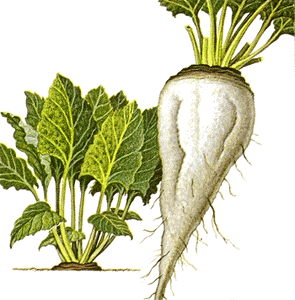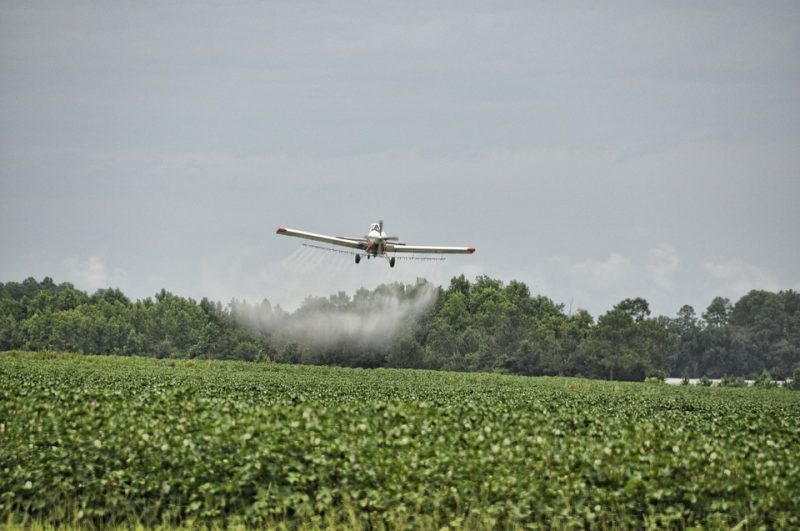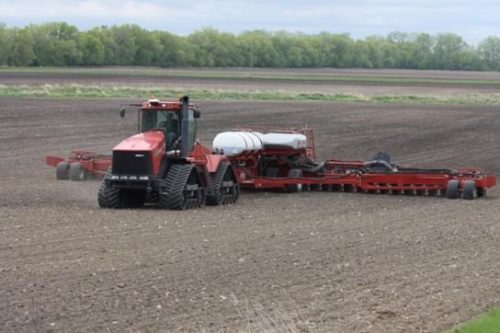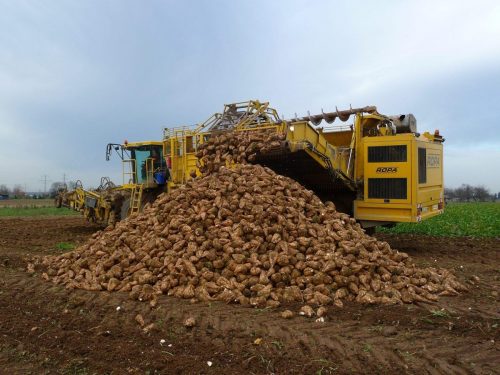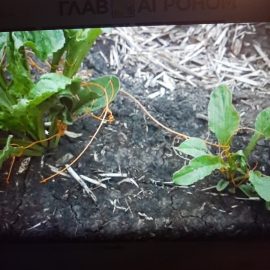Sugar beet, cultivation and harvesting technology
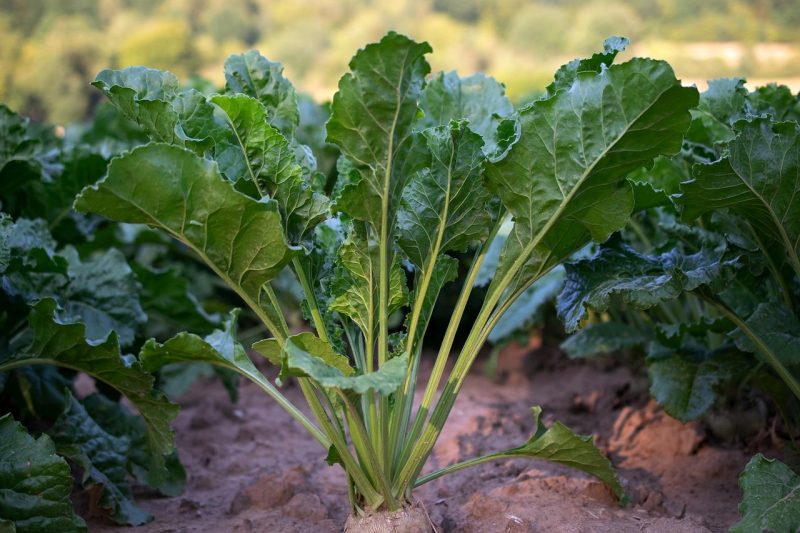
Sugar beet (Beta vulgaris var. saccharifera) is a popular crop, very profitable, which reacts well to fertilization, water from soil, or irrigation, being a good precursor to most crops. Sugar beet also helps to destroy weeds and helps to structure the soil. Sugar beet is primarily used as a raw material in the sugar industry. The molasses resulting from the processing of beets is used in the food industry and in the alcohol industry.
This type of beet is a biennial plant. In the first year of vegetative growth, the body of the beet is formed. In the second year, the branches which bear the fruit develop. The body of the beet is harvested in the first year of vegetative growth and is made up of epicotyl, hypocotyl and root. The leaves have long petioles and the foliar limb is elongated, oval. The leaf can be straight or it can lay on the ground. The flower is sessile. The seeds are of different sizes and weights, have an ellipsoidal shape, with a sickle-shaped embryo.
Environmental and soil requirements
The minimum germination temperature is 3-4 °C, and beets need 2400-2900 °C in the first year of vegetative growth and about 1800 °C in the second year. The accumulation of sugar stops at a temperature of 5 °C. Sugar beet is pretentious to water, high yields being obtained in areas where 500-600 mm rainfall falls annually. Drought periods in June, July, and August lead to qualitative and quantitative depreciation. Sugar beet is a plant that makes good use of light energy and needs an average of five hours of light a day. Soils conducive to sugar beet cultivation are those with a loamy-sandy, deep texture, and with a high water retention capacity. It is not recommended to grow beets in compact soils.
Sugar beet crop technology
Crop rotation
The best precursor plants are those that are harvested and removed from the soil early so that there is time for the proper field works and fertilization. A 4-year crop rotation is recommended. The best precursors are straw cereals. Cruciferous vegetables and oats, sunflower, corn, hemp, sorghum, or Sudan grass are not recommended as precursors. Sugar beet is a good precursor plant for barley, wheat, corn, or barley.
Fertilization
Sugar beet is a major consumer of nutrients. Nitrogen is important for plant growth. Phosphorus promotes the growth of roots, the leaves and increases the sugar content. Potassium promotes the absorption of nitrogen and phosphorus, the synthesis and migration of sugar in the roots. A boron deficiency causes the leaves to turn yellow and the center of the beet to rot. Manure increases production on all types of soil. The application of phosphorus and potassium fertilizers should be carried out together with the basic plowing. The nitrogen-based fertilizers have to be applied in stages, when preparing the seedbed and during the vegetative growth period. The application of foliar fertilizers can bring important production increases.
Recommended products
-
You can find products on a different store
Change Store -
You can find products on a different store
Change Store -
You can find products on a different store
Change Store -
You can find products on a different store
Change Store -
You can find products on a different store
Change Store -
You can find products on a different store
Change Store -
You can find products on a different store
Change Store -
You can find products on a different store
Change Store -
You can find products on a different store
Change Store -
You can find products on a different store
Change Store -
You can find products on a different store
Change Store -
You can find products on a different store
Change Store -
You can find products on a different store
Change Store -
You can find products on a different store
Change Store -
You can find products on a different store
Change Store -
You can find products on a different store
Change Store -
You can find products on a different store
Change Store -
You can find products on a different store
Change Store -
You can find products on a different store
Change Store -
You can find products on a different store
Change Store -
You can find products on a different store
Change Store -
You can find products on a different store
Change Store -
You can find products on a different store
Change Store -
You can find products on a different store
Change Store
Field works
After clearing the land, the stubble plowing work must be carried out. The aim is to preserve the water in the soil and level the ground. Plowing should be done at a depth of 28-30 cm. It is advisable to adhere to the plowing depth because it considerably influences the production. The preparation of the seedbed should be done with the help of the combine. The depth must not exceed 4 cm.
Seeds and sowing
Certified seeds with a minimum purity of 99% and minimum germination of 75% must be used. It is recommended to use special seeds (coated with a film, containing a binder, insecticides, herbicides, bio stimulators, sometimes even nutrients and trace elements) to ensure precise sowing. Sowing has to be done when the soil temperature is 3-4 °C. The sowing density is calculated so that at harvest to be 100-110 thousand plants/ha. The sowing distance is usually 45 cm. The quantity of seeds is between 8-12 kg/ha for multigerm varieties and 5-8 kg/ha for monogerm varieties. The sowing depth is 2-4 cm.
Weed control
One of the most important maintenance works is weed control. To keep the crop free of weeds, mechanical weeding or specific herbicides can be applied.
Recommended products
-
You can find products on a different store
Change Store -
You can find products on a different store
Change Store -
You can find products on a different store
Change Store -
You can find products on a different store
Change Store -
You can find products on a different store
Change Store -
You can find products on a different store
Change Store -
You can find products on a different store
Change Store -
You can find products on a different store
Change Store -
You can find products on a different store
Change Store -
You can find products on a different store
Change Store -
You can find products on a different store
Change Store -
You can find products on a different store
Change Store -
You can find products on a different store
Change Store -
You can find products on a different store
Change Store -
You can find products on a different store
Change Store -
You can find products on a different store
Change Store -
You can find products on a different store
Change Store -
You can find products on a different store
Change Store -
You can find products on a different store
Change Store -
You can find products on a different store
Change Store -
You can find products on a different store
Change Store -
You can find products on a different store
Change Store -
You can find products on a different store
Change Store -
You can find products on a different store
Change Store
Diseases and pests
The most important diseases that can occur in sugar beet crops are bacterial leaf spot, Pythium root rot, downy mildew, powdery mildew, blackleg of beet, Cercospora leaf spot disease. Among the pests, the most common are sugarbeet nematode, beet lace bug, black bean aphid, sugarbeet weevil, sugarbeet flea beetle, beet moth, American serpentine leafminer.
Irrigation
In order to obtain high yields, irrigation is recommended in areas with a deficit of precipitation. The first watering is done in mid-June using a rate of 500-600 cubic meters/ha. It is recommended to water the crop 5-7 times throughout the vegetative growth period, using 3000-5000 cubic meters/ha, depending on the area.
Harvesting
The best time to harvest is when the beets have reached maturity (the roots have the maximum weight and maximum sugar content). Visually we can appreciate the maturity of the beet when the leaves are light green, and the formation of new leaves ceases. Particular caution should be paid when removing the beet leaves. In order to work in good conditions, with minimal losses, the soil must be level, without boulders and without weeds. After harvesting, the beets must remain in piles in the field.














































































































































































































































































































































































































































